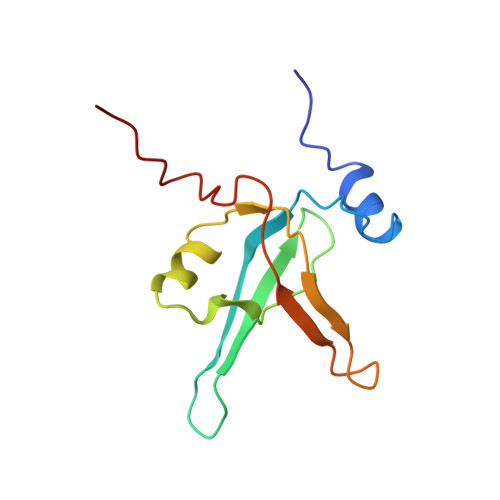Human replication protein A: global fold of the N-terminal RPA-70 domain reveals a basic cleft and flexible C-terminal linker.
Jacobs, D.M., Lipton, A.S., Isern, N.G., Daughdrill, G.W., Lowry, D.F., Gomes, X., Wold, M.S.(1999) J Biomol NMR 14: 321-331
- PubMed: 10526407
- DOI: https://doi.org/10.1023/a:1008373009786
- Primary Citation of Related Structures:
1EWI - PubMed Abstract:
Human Replication Protein A (hsRPA) is required for multiple cellular processes in DNA metabolism including DNA repair, replication and recombination. It binds single-stranded DNA with high affinity and interacts specifically with multiple proteins. hsRPA forms a heterotrimeric complex composed of 70-, 32- and 14-kDa subunits (henceforth RPA70, RPA32, and RPA14). The N-terminal 168 residues of RPA70 form a structurally distinct domain that stimulates DNA polymerase alpha activity, interacts with several transcriptional activators including tumor suppressor p53, and during the cell cycle it signals escape from the DNA damage induced G2/M checkpoint. We have solved the global fold of the fragment corresponding to this domain (RPA70 delta 169) and we find residues 8-108 of the N-terminal domain are structured. The remaining C-terminal residues are unstructured and may form a flexible linker to the DNA-binding domain of RPA70. The globular region forms a five-stranded anti-parallel beta-barrel. The ends of the barrel are capped by short helices. Two loops on one side of the barrel form a large basic cleft which is a likely site for binding the acidic motifs of transcriptional activators. Many lethal or conditional lethal yeast point mutants map to this cleft, whereas no mutations with severe phenotype have been found in the linker region.
Organizational Affiliation:
Environmental Molecular Sciences Laboratory, Pacific Northwest National Laboratory, Richland, WA 99352, USA.













